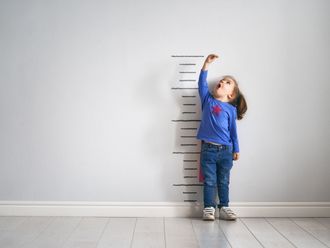
In this era of working from home and schooling from home and exercising from home and making sourdough from home, the question will soon present itself: What else is there to do from home?
For kids, the answer might be to publish a newspaper from home – especially at a time of year when there are traditionally Round Robins summing up what has been a very unique year for everyone. And now there are ample apps and websites to turn their ideas into real publications.
Kids starting their own paper is like a dam with a crack. And the moment they realize they have complete agency to report what they want, write what they want, as well as add comics? That's the flood.
The upsides to a homegrown newspaper are myriad. Kids learn how to investigate and listen, differentiate between reliable and unreliable sources, research and fact-check, and, perhaps most importantly, learn that their own interests have value. Plus a kitchen-table newspaper does wonders for a child's writing and editing skills.
Children by their very inquisitiveness have the makings of a great journalists. Can wood melt? How do you make an iPhone? Where does God live? Could this egg become a chicken? They are innately curious, naturally unbiased and typically don't let up until their questions are answered.
Here are some instructions for any budding journalists wishing to embark on a do-it-yourself literary adventure.
Choose a title
Most people find that the most inspiring first step is titling the publication. Maybe the newspaper is named after the kids' neighbourhood, emirate or pet. Add a secondary word like Dealer, Daily, Weekly, Post, Bulletin, Sentinel, Gazette, Tribune, Globe, Observer, Journal or even News, and you've got yourself a newspaper name. Meera's Herald, The Arabian Ranches Chronicle, The Bur Dubai Times - they all sound highly credible.
Think about topics
Next, they need to think about what topics they want to cover. If kids actually sit at a table and write down all of their ideas, they have technically had their first editorial meeting. Discipline and structure aren't going to be the easiest skills to embrace (they are likely to be the hardest), but they are necessary. Even in the loosest possible way.
Brainstorm stories
Coming up with story ideas can be daunting, especially to little kids, so maybe start with the sections they want: sports, school, climate. Or perhaps politics, opinion or comics, jokes and games. Pets and snacks and presidential cartoons? Sure! Even the vaguest idea of sections will inform the work ahead. (Kids can skip this step and jump right into content, but that approach has a greater chance of confusion, infighting and slammed doors.)
Understand the roles involved
Whether working with siblings or other kids remotely, the teamwork required in establishing duties and meting out responsibilities cannot be underestimated. This phase is guaranteed to raise tempers; there may be tears. You may want to skip this phase altogether, but that's a bad idea, unless you plan to publish "The Lord of the Flies Herald." Once you have a sports editor, someone in charge of the cover art, a photo director, a makeshift city desk, perhaps even a food critic, tasks will flow easier and kids will come out stronger on the other side.
(Note: This even works if a single child is producing the whole paper - it helps to know the different jobs there are to do.)
Differentiate between sources
The first thing a reporter needs to know is where to get information. This is a great opportunity for kids to learn the difference between primary sources (an interview with the owner of a local music store) and secondary sources (reading a reliable article about the best music of 2020). While primary sources are always preferable, they're not always necessary - and an interview with Camila Cabello is probably not in the cards.
The best reporting usually involves interviewing an expert. This might sound daunting until they realize: Everyone is an expert in something. The expert may be a teacher or a student talking about virtual learning, the owner of a dog rescue explaining how to adopt a Saluki or a school librarian on the best scary books for 10-year-olds.
The young reporter's job is to find experts who can supply information that is both factual and relevant.
It may not always be possible to obtain interviews, so an understanding of credible online sources is important. Any Google search will most likely take the reporter to Wikipedia, for example. But given that it is a crowdsourced content hub, Wikipedia cannot be trusted as a credible source. A good alternative is brittanica.com, any website with a .gov or .edu address, a reliable newspaper or Google Scholar (which is reliable, if a bit dense for kids).
Start writing
For the novice, a question-and-answer format is a great place to start since it doesn't require much writing beyond transcribing the interview. Writing an actual article - one with an introduction, supporting facts and a conclusion - is terrific practice and often mirrors what sixth and seventh graders are learning in school. (It's also fun to pick out examples of writing forms for kids to play with: profiles, recipes, captions, news blurbs, even hot takes.)
Don’t forget the crossword
History tells us that a newspaper is not a newspaper without a crossword. If there was ever a place to put arbitrary facts to good use, it is here. Puzzlemaker.discoveryeducation.com or CreateWordSearchPuzzle.com do the work of building the puzzle, so the kids can focus on the theme, the words and the clues.
…Or the comics
The comics section will not be a hard sell. And while a child's initial attempts may not reach the level of uproarious, they are creative-inspiration gold. Websites like storyboardthat.com and canva.com let the artist choose a scene, select a template and drop in characters.
Learn about attribution
For a lot of kids, creating a piece of journalism will seem as simple as cutting and pasting an article from The New York Times and putting it in quotation marks with an attribution at the end. A teaching moment! Have them put that piece in their own words and get another source. But plagiarism goes beyond cutting and pasting. Encourage children to ask themselves where the idea came from, if they used any of the same words as one of their sources, or if they borrowed a phrase, joke or idea from someone else and forgot to give credit.
The creative director is very likely to be the same person as the sports editor and the crossword writer. Again, the rules of plagiarism apply: An amazing picture of a polar bear in the local paper is not up for grabs without permission or proper attribution. Kids can explore a stock website, like istockphoto.com, which has a massive inventory of images for sale.
The final touch
Making it look like a real newspaper is the fun part. My Newspaper app (available on an iPhone or iPad), newspaperclub.com and makemynewspaper.com are all user-friendly options with pre-existing templates. Should the newspaper become a magazine, websites like flipsnack.com and canva.com can accommodate templates, layouts and printing.
For distribution, kids can walk around the neighbourhood, pass it out on the corner, maybe even start their own newspaper bike route. Just be sure each copy has an email address so that readers can comment on all the hard work.








